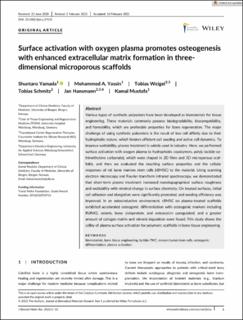| dc.contributor.author | Yamada, Shuntaro | |
| dc.contributor.author | Yassin, Mohammed Ahmed | |
| dc.contributor.author | Weigel, Tobias | |
| dc.contributor.author | Schmitz, Tobias | |
| dc.contributor.author | Hansmann, Jan | |
| dc.contributor.author | Mustafa, Kamal Babikeir Eln | |
| dc.date.accessioned | 2021-08-17T13:32:04Z | |
| dc.date.available | 2021-08-17T13:32:04Z | |
| dc.date.created | 2021-03-08T11:16:48Z | |
| dc.date.issued | 2021 | |
| dc.identifier.issn | 1549-3296 | |
| dc.identifier.uri | https://hdl.handle.net/11250/2768941 | |
| dc.description.abstract | Various types of synthetic polyesters have been developed as biomaterials for tissue engineering. These materials commonly possess biodegradability, biocompatibility, and formability, which are preferable properties for bone regeneration. The major challenge of using synthetic polyesters is the result of low cell affinity due to their hydrophobic nature, which hinders efficient cell seeding and active cell dynamics. To improve wettability, plasma treatment is widely used in industry. Here, we performed surface activation with oxygen plasma to hydrophobic copolymers, poly(L-lactide-co-trimethylene carbonate), which were shaped in 2D films and 3D microporous scaffolds , and then we evaluated the resulting surface properties and the cellular responses of rat bone marrow stem cells (rBMSC) to the material. Using scanning electron microscopy and Fourier-transform infrared spectroscopy, we demonstrated that short-term plasma treatment increased nanotopographical surface roughness and wettability with minimal change in surface chemistry. On treated surfaces, initial cell adhesion and elongation were significantly promoted, and seeding efficiency was improved. In an osteoinductive environment, rBMSC on plasma-treated scaffolds exhibited accelerated osteogenic differentiation with osteogenic markers including RUNX2, osterix, bone sialoprotein, and osteocalcin upregulated, and a greater amount of collagen matrix and mineral deposition were found. This study shows the utility of plasma surface activation for polymeric scaffolds in bone tissue engineering. | en_US |
| dc.language.iso | eng | en_US |
| dc.publisher | Wiley | en_US |
| dc.rights | Navngivelse 4.0 Internasjonal | * |
| dc.rights.uri | http://creativecommons.org/licenses/by/4.0/deed.no | * |
| dc.title | Surface activation with oxygen plasma promotes osteogenesis with enhanced extracellular matrix formation in three- dimensional microporous scaffolds | en_US |
| dc.type | Journal article | en_US |
| dc.type | Peer reviewed | en_US |
| dc.description.version | publishedVersion | en_US |
| dc.rights.holder | Copyright 2021 The Authors | en_US |
| cristin.ispublished | true | |
| cristin.fulltext | original | |
| cristin.qualitycode | 1 | |
| dc.identifier.doi | 10.1002/jbm.a.37151 | |
| dc.identifier.cristin | 1896292 | |
| dc.source.journal | Journal of Biomedical Materials Research. Part A | en_US |
| dc.source.pagenumber | 1560-1574 | en_US |
| dc.relation.project | Trond Mohn stiftelse: BFS2018TMT10 | en_US |
| dc.identifier.citation | Journal of Biomedical Materials Research. Part A. 2021, 109 (9), 1560-1574. | en_US |
| dc.source.volume | 109 | en_US |
| dc.source.issue | 9 | en_US |

